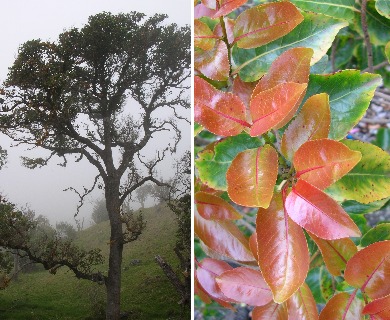Maua
Xylosma hawaiiense
Poplar-Willow family (Salicaceae)
Native species ()
Handsome small native tree mostly of dry forests, with shiny broadly elliptical leaves, edges straight or finely wavy and small greenish or reddish flowers, male and female on different trees. To 60 ft (18 ) tall and 1 1⁄2 ft (0.5 ) in trunk diameter, usually smaller and often only 15 ft (4.6 ) high, with a spreading rounded of slightly drooping branches. Bark gray, smoothish, sometimes warty, becoming thick, rough, and furrowed into small scaly plates. Inner bark is light yellow or orange within the green outermost layer, bitter. Twigs are hairless, dark red and slightly angled when young, becoming gray brown with raised dots and raised half-round leaf scars. End bud 1⁄8 inch (3 ) long, rounded, brown, scaly.

©2006 Forest And Kim Starr
Flower clusters () at bases of new leaves or back of leaves, 1⁄2–1 inch (13–25 ) long, unbranched. Flowers mostly male and female on different trees (), several, greenish or reddish, about 1⁄4 inch (6 ) long and broad, without petals, on slender pinkish stalks. Male flowers with cuplike of 4–5 rounded finely hairy or hairless less than 1⁄8 inch (3 ) long and above a many threadlike spreading 1⁄4 inch (6 ) long with dot-like sometimes with Female flowers with 4–5 and composed of elliptical 1-celled sometimes a short and 2–4 flattened stigmas.
() rounded or elliptical, about 1⁄2 inch (13 ) long, bluish, blackish, or reddish, slightly shiny, with at base and stigmas at slightly fleshy or nearly dry, bitter, astringent, and not edible. Seeds one or two, elliptical, about 1⁄4 inch (6 ) long, brown.
Wood is reddish brown with light and dark banding resembling growth rings, heavy, hard, brash, but easily worked.
Widely distributed and common locally in dry forests through the islands, especially on leeward sides, at 800–4500 ft (244–1372 ) elevation. Windswept and stunted where exposed. Found on a‘ā (rough) lava fields.
Borer insects attack and kill the branches.
Special areas
Kokee, Volcanoes, Kipuka Puaulu
Champion
Height 58 ft (17.7 ), c.b.h. 5.1 ft (1.6 ), spread 43 ft (13.1 ). Hoomau Ranch, Honomalino, Hawaii (1968).
Range
Hawaiian Islands only
Botanical
Drypetes forbesii Sherff.





